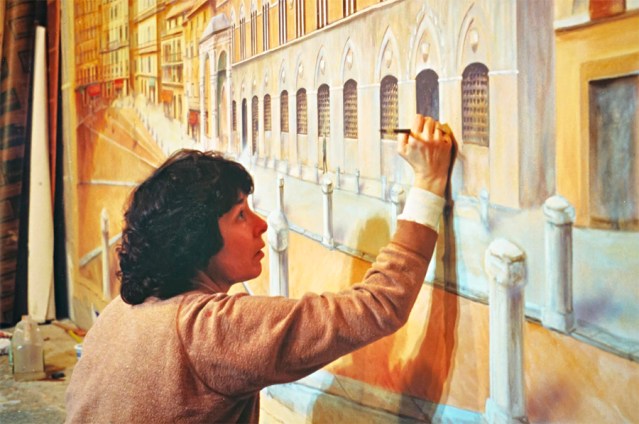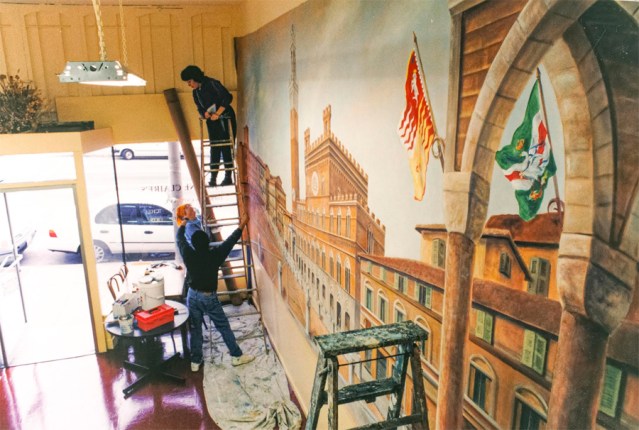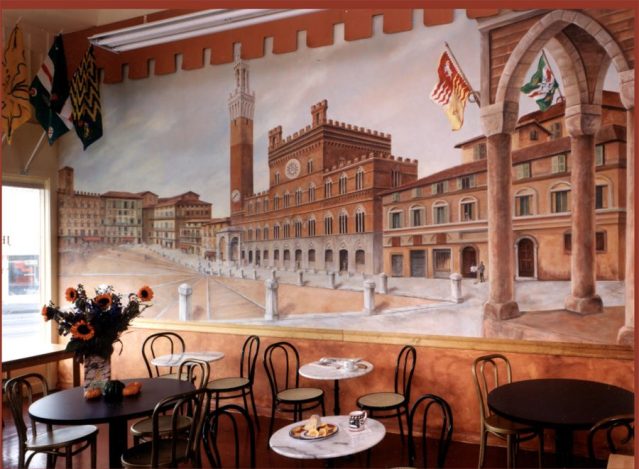By Herbert F. Mintz II
A visit to El Cafe, the latest business located on the northside corner of Taraval and 24th Avenue in the Sunset/Parkside District, offers customers more than a cup of organic coffee and a tasty sandwich.
For those who, pre-pandemic, found themselves wandering about in search of educational travel experiences, the interior of El Cafe includes a chance to gaze upon a one-of-a-kind mural of the Piazza del Campo, a vast open air public square in the Italian Tuscan hill town of Siena.
The mural is a project of two muralists: Jennifer Ewing and her husband Leo Germano. Known as the creative team of Ewing and Germano, they live in San Francisco and have an artist’s studio in the Mission. Leo’s strong suit is the drafting, which is seen as the bones for the painting; for Jennifer, it is color and effects. Inspired by their travels in Europe, Ewing and Germano specialize in Mediterranean subjects. They create similar projects in homes and businesses. They have been in the decorative painting business since 1989.
“The story of the cafe mural begins with a client who loved Siena, Italy, and would visit there annually,” Jennifer wrote in an email. “She was a passionate Italophile and had a vision for her new cafe at 24th and Taraval in 1995. The large wall was ideal to hold a mural.”
When I first viewed the large mural in the late 1990s, its representational, almost photographic detail of the Piazza del Campo with its Italian medieval architecture and Gothic overtones, was matched only by its immense beauty. The mural’s soft harmonious pastels, even-tonal values, fine geometric lines and angled composition move the viewer’s attention effortlessly across the expansive image.
The Piazza del Campo is depicted slightly off center with a slight left-to-right slope. Its nine oddly shaped quadrants are all clearly marked and are all pointing toward the City Hall building, the massive Palazzo Pubblico.
A proposal for a mural was produced by Jennifer and Leo based on their visits to Italy and, in particular, Siena. The client approved and their work began.
“The El Cafe mural is painted on canvas that is glued to the wall. This meant that the mural could be designed and painted in our studio. It cafe mural took about 60 days to complete and attach. We don’t remember nor do we pay strict attention to time. It is about how much we can enjoy the work.”
But there were challenges.
“It was installed on site and that required plenty of adjustments and physical effort,” Jennifer said, “Mural means painting on the wall and this artwork qualifies as a mural since it is directly on the wall.
“The Piazza Del Campo in Siena has an eternal kind of resonance with people,” she said. “The design of the common space is created so that the spectator’s eye level is at the same level as the dignitaries. It is meant to be a more democratic kind of experience.”
On a sad note, Jennifer remarked, “After the original owner sold the business, the mural remained in situ because it was so big and too difficult to de-install. Once the Italian connection was lost, it seems a bit out of context.”
And so it seemed. Sold to various owners over the years, I wondered as walked by (and occasionally entered): What would become of the attractive mural? One owner straightened the front wall in order to expand the floor space. The space was even used to house the Gavin Newsom Sunset/Parkside mayoral campaign office. There were times when the space was empty.
But the series of new owners of the business must have recognized the timeless value of the work and the mural survived, giving me another chance to divine its secrets.
After my second visit to Siena, I realized that the Cafe mural is a project where both captivating beauty and history intersect. The beauty is obvious; the spirit of its history radiates at a lower frequency and is harder to detect.
Let me show you.
Let’s look again at the Cafe mural. It is no accident that the Palazzo Pubblico, Siena’s City Hall, rises above the oval shaped square, the Piazza Del Campo, unaccompanied by an equally huge Cathedral, itself a common site on most Italian central public squares. When the Piazza del Campo was built in 1297, The Republic of Siena was a wealthy self-governing municipality or city-state, administered by a rotating group of representatives of Siena’s leading families that formed a City Council and ruled from 1285 to 1355. This period is considered to be one of the most stable and prosperous governments in Italy.
Do you see those nine oddly shaped quadrants pointing directly at the Palazzo Pubblico? Each section is of equal size and represents one of the nine ruling governors, the so-called Government of the Nine. With all lines pointing to the Palazzo Pubblico, the City Hall, the high point of the square and mural, the symbolism is also deliberate: Siena is a republic where secular officials shared power and used their best judgements to develop rational policies insuring good government and future prosperity.
The Government of the Nine of Sienna, whose members only served for two months at a time, met in the Palazzo Pubblico’s Room of Peace, or Hall of the Nine, where they were surrounded by three large-scale painted ‘message’ frescos illustrating the positive and negative outcomes of their policy decisions regarding government in Siena.
These works of art carried a strong social message of the value of stable republican government that residents of Siena expected of their government.
The three large frescoes are The Allegory of Good Government, The Effects of Good Government in the City and the Country and The Allegory and Effects of Bad Government in the City and the Country.
These frescos are the master work of Ambrogio Lorenzetti completed between 1337 and 1340. Any member of the Government of the Nine who entered the Room of Peace would be confronted by the commanding imagery of these frescoes making it clear the onerous responsibility of wielding governmental power.
Simply stated, The Allegory of Good Government fresco represents series of personifications of the virtues and objectives which represent, allegorically, what the priorities and moral ethics should be of all those involved in governing. The higher ideals involved in the maintenance of responsible government are common sense, peace, prudence, faith, charity, magnanimity, fortitude, temperance, hope and justice. In the same fresco, the citizens of Siena are bound together by a symbolic cord, connecting them to these higher ideals, their leaders and their public participation.
The Effects of Good Government in the City and the Country fresco portrays the results that are to be expected if the ideals of good government are put into practice. In the City, everyone seems to have a job, trade flourishes, there is time to recreate, the city streets are clean, people move about freely and are respected, visitors arrive and are welcomed, city buildings are strong and secure and everyone seems to have a home. It is a wonderful place to live. In the countryside, farmers cultivate productive land and people work in harmony. Harvested products are brought to the city markets. There is plenty for everyone.
The Allegory and Effects of Bad Government in the City and the Country, as you can expect, portrays a city ruled by corrupt and selfish officials seeking to take advantage of their positions of power. The personification of tyranny underscores the negative policies of avarice, cruelty, fraud, vainglory, divisiveness and war. In the City, the streets are dirty, shops are empty, residents seemed frightened, buildings are damaged and the only job that is flourishing is a blacksmith making weapons. In the countryside, the land seems burnt and is suffering from a drought, there is a thick haze (air pollution?) and it seems depopulated.
Are you thinking what I am thinking?
It is clear now that important lessons resonate from those frescoes through the centuries and seem all too timely for the residents of San Francisco and the nation today. Headlines with saddening details report that city officials and citizens are under investigation by the FBI. Corruption doesn’t end at the City’s limits; the nation has its share of bad political actors, including those involved in recent mob violence in Washington, DC.
Maybe you are also thinking, where are our allegories of good and bad government?
We can start with the El Cafe mural Piazza del Campo at the El Cafe and recognize its value as a starting point for another kind of educational travel adventure.
So, the next time you go to the El Cafe to enjoy something wonderful to eat and/or drink, if you have to wait in line wearing a mask and stay socially distance, take a look at the mural of the Piazza del Campo and imagine the import of its timeless beauty and history, and its relationship to the ageless frescos inside the Palazzo Pubblico. Better yet, take a risk and strike up a conversation with someone else in line and talk about what we can do to get the good government we deserve.
With that simple gesture, you can bring the El Cafe mural to life.

The Allegory of Good Government. Photo by Jose Luiz. https://creativecommons.org/licenses/by-sa/4.0/deed.en. No changes were made.


The Effects of Good Government in the Country.

The Allegory of Bad Government. Photo by Jose Luiz. https://creativecommons.org/licenses/by-sa/4.0/deed.en. No changes were made.

The Effects of Bad Government in the City.

Photos below are courtesy of Jennifer Ewing.

Jennifer painting the mural in her studio.

Hanging the mural in the cafe.

Categories: Art











